Bewertungsregeln
From LimeSurvey Manual
Einleitung
LimeSurvey enthält eine Funktion, die es Umfrageadministratoren ermöglicht, Umfrage-"Bewertungen" für seine oder ihre Befragten zu erstellen - sogar für mehrsprachige Umfragen. Assessments sind Regeln, die die Antworten auf eine Umfrage unmittelbar nach deren Übermittlung auswerten und dem Umfrageteilnehmer (basierend auf dieser Auswertung) Textblöcke anzeigen.
Um die Bewertungsfunktion von LimeSurvey zu verwenden, rufen Sie das Umfrage-Menü' auf und klicken Sie auf die Registerkarte Bewertungen:
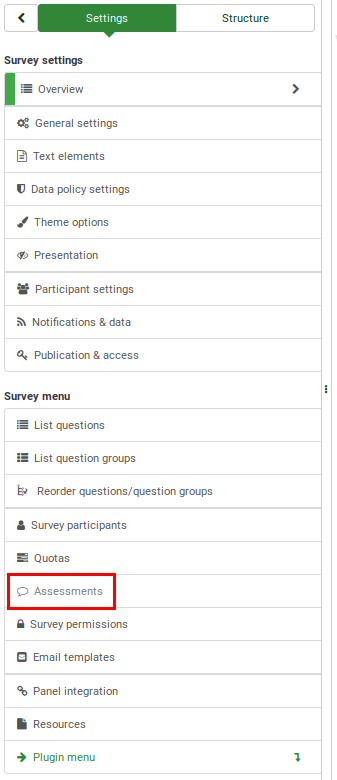
Dort angekommen, aktivieren Sie den Bewertungsmodus:

Wie funktionieren Assessments?
Lassen Sie uns ein einfaches Beispiel konstruieren, das Ihnen helfen kann, die Art und Weise besser zu verstehen, wie der Bewertungsmodus funktionieren soll.
Stellen Sie sich vor, Sie hätten zwei Fragen in Ihrer Umfrage, wobei die erste Frage lautet, ob der Benutzer raucht: "Rauchen Sie?". Die Frage hat 3 mögliche Antworten: "Ja, mehr als 10 pro Tag" mit einem Wert von "10", "Ja, aber weniger als 10 pro Tag" mit einem Wert von "5" und "Nein, ich rauche überhaupt nicht" mit einem Beurteilungswert von "1".
Die zweite Frage "Üben Sie Sport aus?" hat drei mögliche Antworten: "Ja, ich übe dreimal pro Woche mindestens eine halbe Stunde lang" mit einem Wert von "1", "Ja, ich übe ab und zu" mit einem Wert von "5" und "Nein, ich mache nie eine Übung" mit einem Antwortcode/Wert von "10".
Wenn wir am Ende der Umfrage die Summen der Werte für jede mögliche Antwort addieren würden, bekämen wir einen guten Hinweis auf den allgemeinen Gesundheitszustand des Befragten. Jemand, der raucht und keine Übungen macht, erhält 10 Punkte für jede Antwort, so dass sich eine Gesamtpunktzahl von 20 ergibt, wenn wir die beiden Werte addieren. Jemand, der nicht raucht und sich nicht körperlich betätigt, erhält für jede Antwort 1 Punkt, so dass sich am Ende eine Gesamtpunktzahl von 2 ergibt.
Bewertungen
Sobald sie aktiviert ist, wird die folgende Seite geladen:
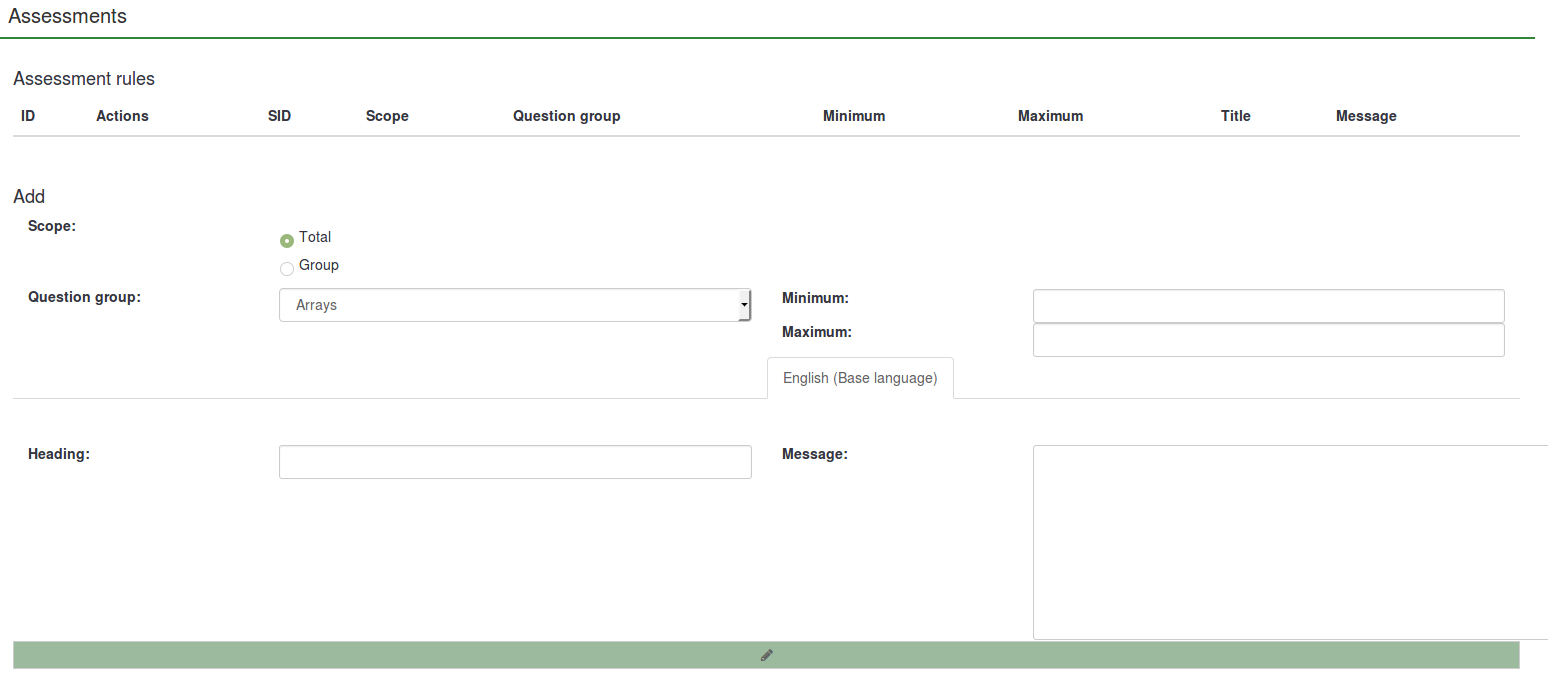
Um mit der Erstellung neuer Bewertungsregeln zu beginnen, füllen Sie die Felder unterhalb der Tabelle Bewertungsregeln aus. Die folgenden Optionen sind verfügbar:
- Geltungsbereich: Sie können entweder Gesamt oder Gruppe wählen. Ersteres erstellt eine Bewertung, die auf der Summe aller eingereichten Antworten in der gesamten Umfrage basiert. Letztere erstellt eine Bewertung, die auf der Summe aller eingereichten Antworten aus einer Fragengruppe basiert;
- Gruppe: Die Dropdown-Liste ermöglicht es Ihnen, die Fragengruppe auszuwählen, die Sie bewerten möchten.
- Minimum: The minimum score to which this assessment will apply.
- Maximum: The maximum score of answers to which this assessment will apply;
- Heading: The heading of the assessment which will be displayed if the assessment is going to be displayed;
- Message: It represents the text message of the assessment - what is displayed at the end of the survey to the respondents. You can use the placeholders such as {PERC} and/or {TOTAL} to emphasize the scores of each survey question group or the total survey score. Click on the green pencil button to access the HTML-editor and enhance the final message of the assessment by adding colours, tables, images, and so on.
Sie können so viele Bewertungen anlegen wie sie möchten. Sie können zu einer bestimmten Punkteanzahl auch mehrere Bewertungen ausgeben lassen.
After adding some assessments, the possible assessments actions will be displayed under the Actions column in the Assessments rules table. From there, you can either edit or delete an assessment rule:
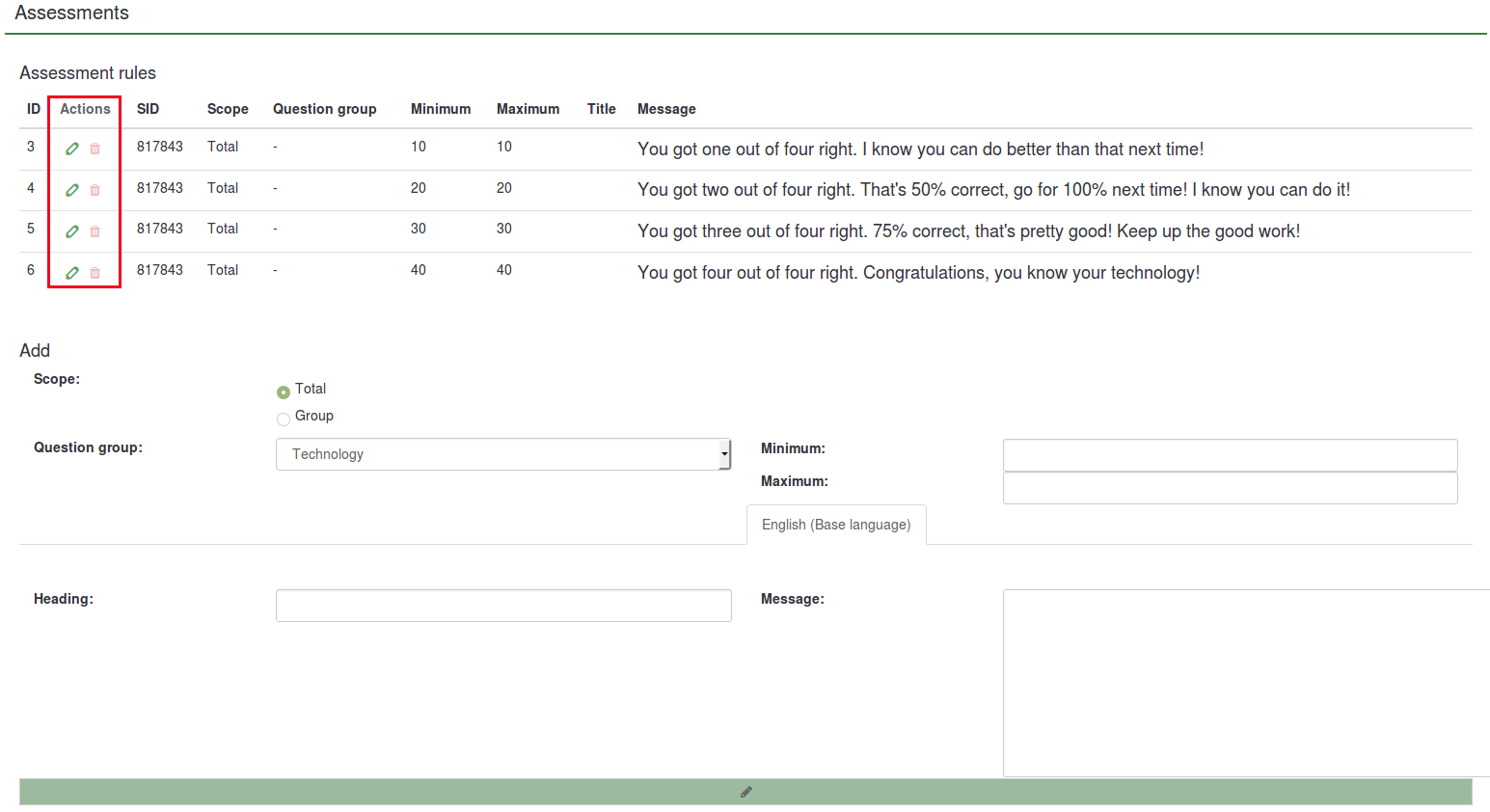
Wichtig ist, wenn sie eine Bewertungen ausgeben möchten, müssen sie ihre Umfrage so anlegen, dass nach dem Absenden der Ergebnisse nicht automatisch eine End-URL geladen wird. Diese Einstellung wird im allgemeinen Einstellungsmenü der Umfrage festgelegt. Denn die Bewertung wird auf der Abschluss-Seite einer Umfrage ausgegeben, welche in dieses Fall sonst übersprungen werden würde.
Auswertung der Punktzuweisungen
Es gibt bestimmte Fragetypen, die nicht bewertet oder auf besondere Weise bewertet werden. Die meisten Fragetypen, die nicht bewertet werden können, sind Convenience-Frage-Typen. Diese können meist durch bewertbare Fragetypen ersetzt werden - zum Beispiel eine 5-Punkte-Auswahl-Frage kann jederzeit durch eine Einfachauswahl-Frage ersetzt werden.
Fragetypen mit Bewertungsregeln
- Array (Flexible labels) dual scale
- Array (Flexible labels)
- Array (Flexible labels) by column
- List (Flexible labels) (Dropdown)
- List (Flexible labels) (Radio)
- List (Dropdown)
- List (Radio)
- List with comment
- Multiple options
- Multiple options with comments
Nicht unterstützte Fragetypen
- 5 point choice
- Array (5 point choice)
- Array (10 point choice)
- Array (Increase, Same, Decrease)
- Array (Multi flexible) (Text)
- Array (Yes/No/Uncertain)
- Boilerplate question
- Date
- Gender
- Huge free text
- Language switch
- Long free text
- Multiple numerical input
- Numerical input
- Ranking
- Short free text
- Yes/No
Bewertungen zuweisen
If enabled, the assessment mode will add an additional field between the answer code and answer option name for all the assessable questions:

You can also use label sets as answers for your set of questions. Just click on the Predefined label sets... button located under the answers matrix and select your predefined label set.
If you decide to use label sets, assessment values can be added to all your labels from the moment in which they are first created. This allows the survey administrator to quickly use few assessed predefined label sets as answers for multiple sets of questions.

This process is less time-consuming and more practical. You can create a plan in the early stages of your survey in order to use only one set of label sets with predefined assessment values for multiple questions. In this way, you will not have to manually add assessment values to all the answers of the assessable questions used in your survey.
Platzhalter
Bei der Nutzung von Bewertungsregeln können die folgenden Platzhalter verwendet werden
- {PERC}: Zeigt den Punktewert für eine Gruppe an. Kann nur innerhalb der abschließenden Meldung genutzt werden.
- {TOTAL}: Zeigt den Gesamtpunktewert an. Kann nur innerhalb der abschließenden Meldung genutzt werden.
- seit 1.86: {ASSESSMENT_CURRENT_TOTAL}: Dieser Platzhalter kann innerhalb eines Fragebogens genutzt werden, um den aktuellen Gesamtpunktestand anzuzeigen, beispielsweise innerhalb eines Hinweistextes einer Frage. Um den Platzhalter nutzen zu können, muss eine Bewertungsregel für den gesamten Fragebogen angelegt sein. Der Wert wird aktualisiert, wenn der Benutzer im Fragebogen auf "weiter" geklickt hat, in einem Fragebogen mit nur einer Seite ist er also nutzlos.
If your survey is not anonymous, the following placeholders are available.
- {TOKEN:EMAIL}: It displays the email of the respondent from the survey participants table
- {TOKEN:FIRSTNAME}: It displays the first name of the respondent from the survey participants table
- {TOKEN:LASTNAME}: It displays the last name of the respondent from the survey participants table
- {TOKEN}: It displays the token code of the respondent from the survey participants table
Tipps & Tricks
- Wenn Sie nur den {ASSESSMENT_CURRENT_TOTAL} Platzhalter innerhalb einer Umfrage benutzen wollen, ohne dass eine Bewertungsnachricht am Ende der Umfrage gezeigt wird, konfigurieren Sie eine End-URL und aktivieren Sie das automatische Laden der End-URL für Ihre Umfrage. Anschließend wird der Nutzer direkt an die angegebene URL weitergeleitet.
- If you only want to use the {ASSESSMENT_CURRENT_TOTAL} placeholder within a survey without showing an assessment message at the end of the survey:
- Access the Survey text elements panel and type in a URL field and
- Enable the autoload URL located in the Presentation panel.
How to disable the assessment mode
To deactivate it, go to the survey menu and look for the Data management tab. Click on it and the Notification and data management panel will be displayed. Look for the Enable assessment mode option and click on it to have it disabled for the respective survey.

Examples
How to use the assessment mode
Let's recreate the example presented above in order to better understand the steps you have to pursue in order to correctly use the assessment feature.
2) Activate the assessments. Go to the settings menu of the survey and click on the Assessments tab. Once there, activate the feature:

3) Create a question group and start adding the questions. Your survey structure should look like this:
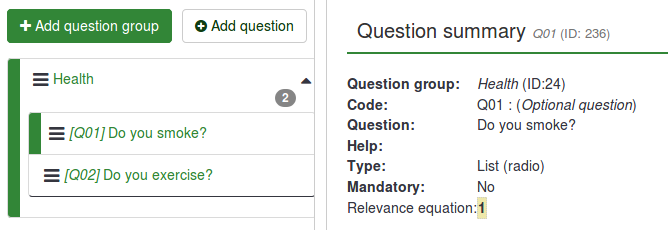
4) Add answers for each question created above. While adding/editing the answers, complete also the assessment value field for each answer:

5) Now that you know the assessment values, access the Assessments panel and start adding assessment rules. Two rules were created for this example:

The text message of the first assessment rule (You should start exercising!) will be displayed if the respondent scores between 1 and 10 points. The text message of the second assessment rule (Well, that's what I call being healthy!) will be shown if the respondent scores between 11 and 21 points.
6) Now, preview the survey and see if the assessment mode is active. At the end of the survey, a text message will be displayed based on the score obtained by the respondent.

How to use the assessment placeholders
As mentioned in the previous subsection, three assessment-related placeholders can be used: {PERC}, {TOTAL}, and {ASSESSMENT_CURRENT_TOTAL}.
In the previous example, the following result was obtained: "Well, that's what I call being healthy!". However, no score was displayed.
There are many ways through which you can have it displayed. You can either create 6 assessment rules in order to emphasize each possible score/result or use assessment placeholders. The below example explains the latter option.
As mentioned above, {PERC} and {TOTAL} can be used in the message text box of the assessment rule in order to emphasize the score of the current group and the total score, respectively. Let's take a look at the following two screenshots to understand their usage.

In the first screenshot, {PERC} and {TOTAL} were added into the message text box of the assessment rule.

In the second screenshot, you can see how the assessment rule looks like in order to correctly use both placeholders. Because {PERC} is used, the scope of the assessment rule must be switched from Total to Group in order to correctly display the score of the question group selected from the Question group dropdown list:

After completing the survey and depending on their answers, the respondents should get the following assessment message at the end:
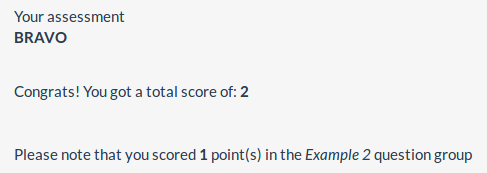
{ASSESSMENT_CURRENT_TOTAL} can be used only inside a survey. You can use it after each question or question group from a quiz. You could show in this way to each respondent his or her current quiz/survey score. To use it, you could add for example at the beginning of every question or question group a message like: "You have accumulated till now {ASSESSMENT_CURRENT_TOTAL} points".
Video tutorial
To understand the basics of the LimeSurvey assessments feature, check the following video.